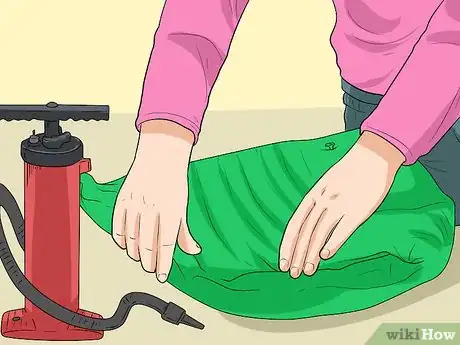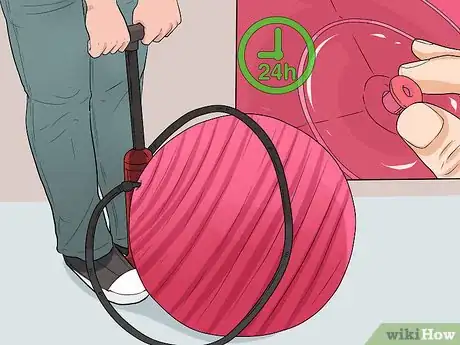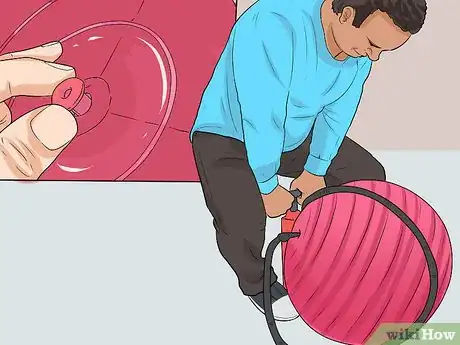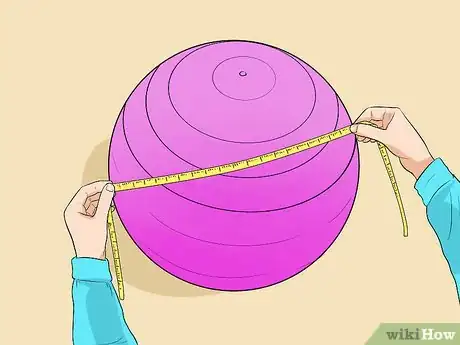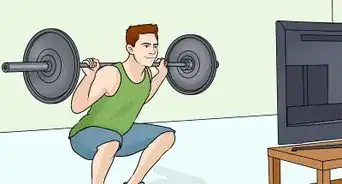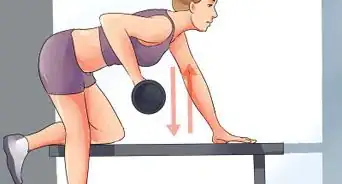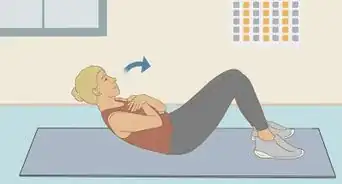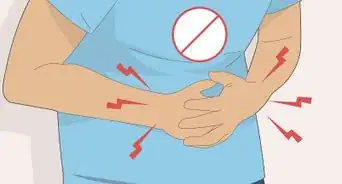This article was co-authored by Michele Dolan. Michele Dolan is a BCRPA certified Personal Trainer in British Columbia. She has been a personal trainer and fitness instructor since 2002.
wikiHow marks an article as reader-approved once it receives enough positive feedback. In this case, 89% of readers who voted found the article helpful, earning it our reader-approved status.
This article has been viewed 300,011 times.
Exercise or stability balls can be used in a variety of ways to improve your posture or to aid in physical therapy or training like yoga and Pilates. When using an exercise ball, it's important that it is properly inflated. One that's not correctly inflated could lead to posture problems and won't help you in your workout. Luckily, by following the proper techniques and using the right equipment, you'll be able to inflate and deflate your exercise ball correctly.[1]
Steps
Inflating the Ball
-
1Let the ball sit at room temperature for two hours. Remove your stability ball from the packaging and allow it to sit in a 20°C (68° F) room for two hours. Doing this will normalize the temperature of the plastic and make it easier for you to blow up the ball.
-
2Insert the tip of your ball pump into the hole in the ball. Take the pointed end from your ball pump and place it into the hole in your exercise ball. There may also be an adapter that fits over the nozzle of the pump. This will usually look like a cylinder or cone that comes with your exercise ball. If you have one, simply screw it onto the nozzle of your pump.
- If there is a white plug inside your ball, you'll have to remove it with a butter knife or other object like a key.
- If you are using an electric pump, flip the switch to inflate it.
- If you don't have a plug, you'll have to find replacement parts.
- When removing the plug, be careful not to puncture your ball.
- If your ball didn't come with a pump, purchase one at your local hardware store.
Advertisement -
3Pump the ball up 80% of the way. Push up and down on the handle on your ball's pump to inflate your ball. The ball should start to become bigger as you pump. Once the ball is pumped up, insert the small white plug that came with the ball and allow it to sit for 24 hours before pumping it up again.
- The ball will be very firm at this point.
- If you pump up the ball completely at this point, instead of doing so gradually, it may end up egg-shaped instead of round.
-
4Pump the ball up to its full diameter. After you've allowed the ball to sit, the ball is ready to be pumped its full size. Remove the white plug that you inserted earlier and quickly insert the ball pump adapter into the hole. Continue to pump the ball by pressing up and down on the handle until the ball is filled completely.
-
5Insert the plug and the let the ball sit for another day. Once the ball is fully filled up with air, press the plug back into the hole to stop the air from escaping your ball. Sit your ball indoors for a day before using it.[2]
Checking that Your Ball is Properly Inflated
-
1Measure the final diameter of the ball. Read the instructions or the packaging that your ball came in and got the correct measurements for how large your ball should be when fully inflated. Use a tape measure to measure the diameter of the ball and make sure that it corresponds with what it says in the instructions.[3]
- If you are 4'11"(1.49 m) to 5'6" (1.67 m) tall you should get a 55 cm (1.80 ft) ball.
- If you are 5'7″ (1.70 m) to 6'0″ (1.82 m) tall you should get a 65 cm (2.13 ft) ball.
- If you are 6'1″ (1.85 m) to 6′ 6″ (1.98 cm) tall you should get a 75 cm (2.46 ft) ball.
-
2Sit on your inflated exercise ball. Sit on your ball with your knees slightly bent with your feet flat on the floor. Your knees and hips should be level and your thighs should be parallel to the ground. Look in the mirror to see if you are sinking in too deeply, in which case you'll need to inflate your ball more. If your feet are not flat on the ground or your thighs are sloping downwards, your ball is overly inflated. In this case, release a little air from your ball.
-
3Bounce up and down slowly on your exercise ball. Doing a bounce test will give you an indication of whether your exercise ball is properly inflated. Bounce up and down on the ball and make sure that your hips and shoulders are in a vertical line while you're bouncing. If the ball is able to hold your weight and your posture stays straight, the ball is properly filled up.[4]
- As you work out on your exercise ball, it will slowly deflate over time. Remember to keep the levels of air adequate as time goes on.
Deflating Your Ball
-
1Sit on top of your ball with your legs spread. Move the ball under you and find the white stopper on the ball. Face the stopper in front of you in between your legs.
-
2Remove the stopper and slowly bounce until the ball is deflated. Once you remove the stopper, the air should start escaping from the ball. To speed up the process, lightly bounce on the ball to force the remaining air out of the ball. Continue to do this until it's completely deflated.
-
3Fold up your ball when you store it. When your ball is fully deflated, and you've removed all of the air, fold it several times before putting it back into storage. Do not crumple your ball because it can damage it over time and can create creases and cracks when you inflate it.
- Store your ball at room temperature and don't expose it to direct sunlight.
Expert Q&A
-
QuestionHow much air should be in an exercise ball?
 Michele DolanMichele Dolan is a BCRPA certified Personal Trainer in British Columbia. She has been a personal trainer and fitness instructor since 2002.
Michele DolanMichele Dolan is a BCRPA certified Personal Trainer in British Columbia. She has been a personal trainer and fitness instructor since 2002.
Certified Fitness Trainer Fill the ball until it is the right size—not to a certain pressure. First fill it until it is slightly soft and smaller than the final size. Wait a day and finish inflating it to the size it should be.
Fill the ball until it is the right size—not to a certain pressure. First fill it until it is slightly soft and smaller than the final size. Wait a day and finish inflating it to the size it should be. -
QuestionCan you pop an exercise ball?
 Michele DolanMichele Dolan is a BCRPA certified Personal Trainer in British Columbia. She has been a personal trainer and fitness instructor since 2002.
Michele DolanMichele Dolan is a BCRPA certified Personal Trainer in British Columbia. She has been a personal trainer and fitness instructor since 2002.
Certified Fitness Trainer Exercise balls can burst if they are overloaded, but good quality balls have a 500 pound capacity. Be sure to not over-inflate the ball or store it near a heat source.
Exercise balls can burst if they are overloaded, but good quality balls have a 500 pound capacity. Be sure to not over-inflate the ball or store it near a heat source. -
QuestionHow do you use an exercise ball?
 Michele DolanMichele Dolan is a BCRPA certified Personal Trainer in British Columbia. She has been a personal trainer and fitness instructor since 2002.
Michele DolanMichele Dolan is a BCRPA certified Personal Trainer in British Columbia. She has been a personal trainer and fitness instructor since 2002.
Certified Fitness Trainer The ball can be used as a seat or bench or even as a weight. The right decision depends on what muscles you're trying to work.
The ball can be used as a seat or bench or even as a weight. The right decision depends on what muscles you're trying to work.
Things You'll Need
- Measuring tape
- Large box
- Exercise ball
- Ball pump or bicycle pump
- Cone adapter or needle adapter
- Butter knife
References
- ↑ http://www.fitday.com/fitness-articles/fitness/equipment/benefits-of-an-exercise-ball.html
- ↑ http://www.mediball.com/mediball-inflation-instructions.asp
- ↑ http://www.huffingtonpost.com/annalicia-lynn/fitness-ball-tips_b_6923644.html
- ↑ http://www.dummies.com/health/exercise/filling-your-exercise-ball-tightness-versus-firmness/
About This Article
To air up an exercise ball, start by taking it out of the package and letting it sit at room temperature for a couple of hours so it's easier to inflate. After a couple of hours, insert the tip of the pump into the hole in the ball and use the pump to inflate the ball 80 percent of the way. Then, let the ball sit for 24 hours before inflating it the rest of the way so it doesn't end up egg-shaped instead of round. To learn how to check to see if your exercise ball is properly inflated, scroll down!
